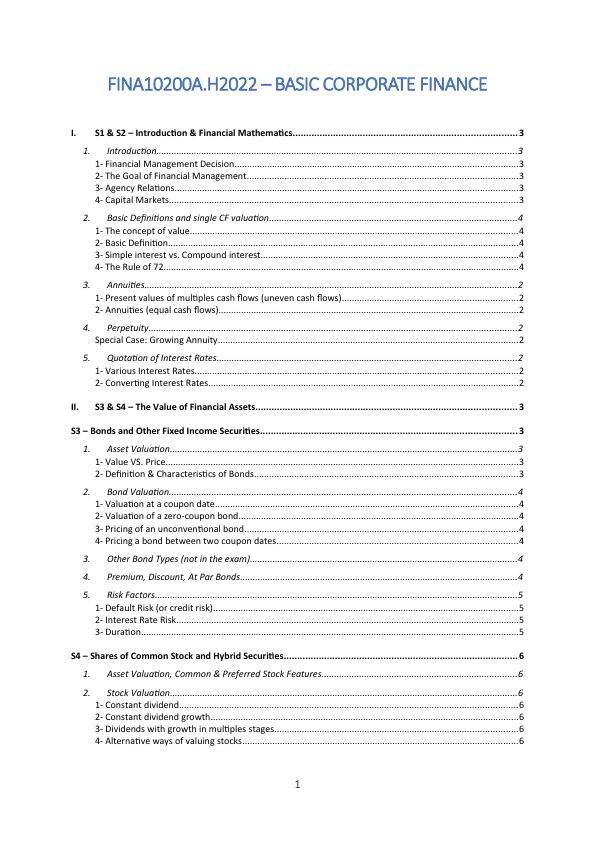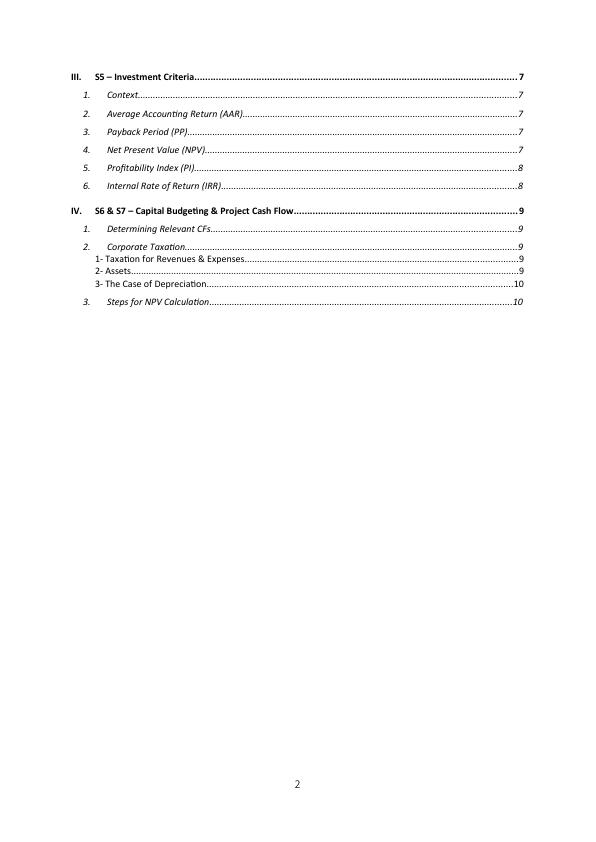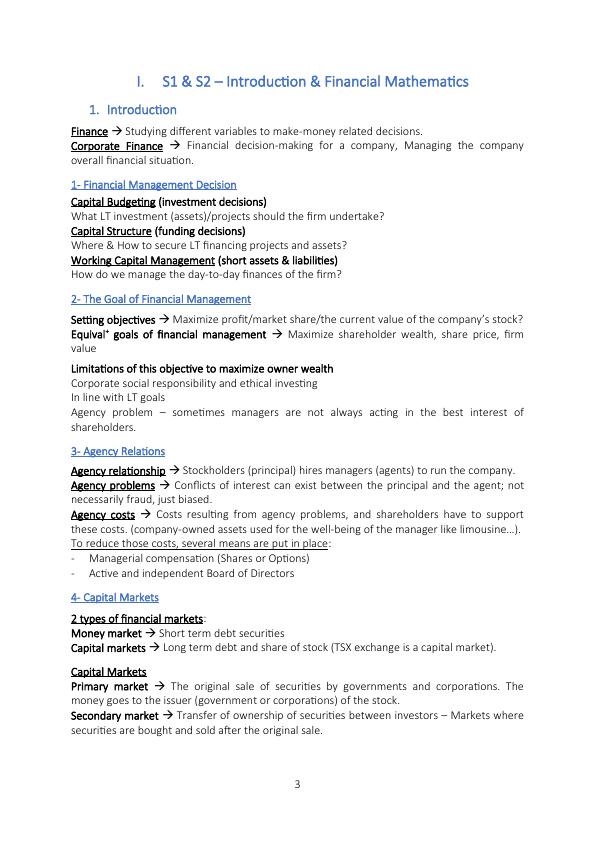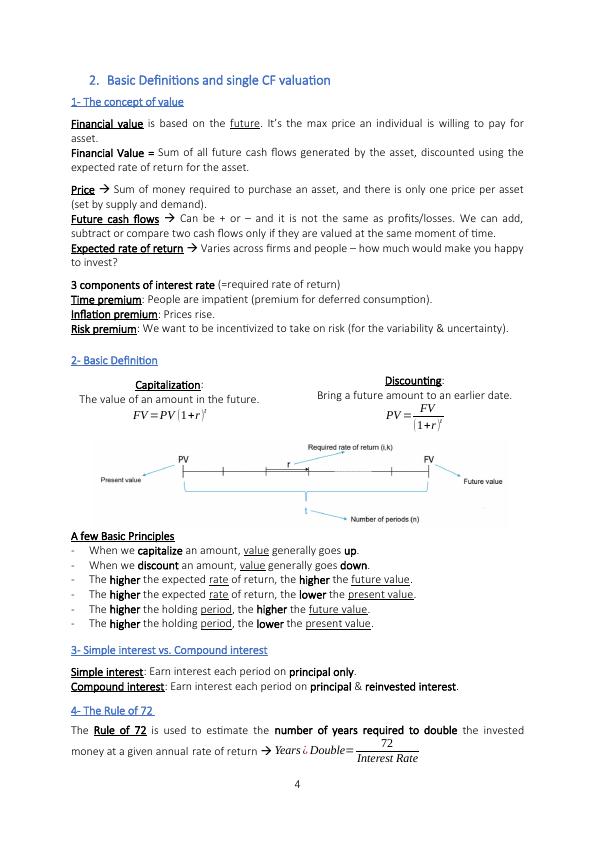FINA10200A.H2022 - BASIC CORPORATE FINANCE I. S1 & S2 - Introduction & Financial Mathematics 3 1. Introduction 3 1- The concept of value 4 2- Basic definitions 4 3- The Rule of 72 4 3. Annuities 2 1-
Added on 2022-02-14
15 Pages3956 Words18 Views
FINA10200A.H2022 – BASIC CORPORATE FINANCE
I. S1 & S2 – Introduction & Financial Mathematics...................................................................................3
1. Introduction................................................................................................................................................3
1- Financial Management Decision.................................................................................................................3
2- The Goal of Financial Management............................................................................................................3
3- Agency Relations.........................................................................................................................................3
4- Capital Markets...........................................................................................................................................3
2. Basic Definitions and single CF valuation...................................................................................................4
1- The concept of value...................................................................................................................................4
2- Basic Definition............................................................................................................................................4
3- Simple interest vs. Compound interest.......................................................................................................4
4- The Rule of 72..............................................................................................................................................4
3. Annuities.....................................................................................................................................................2
1- Present values of multiples cash flows (uneven cash flows)......................................................................2
2- Annuities (equal cash flows)........................................................................................................................2
4. Perpetuity...................................................................................................................................................2
Special Case: Growing Annuity........................................................................................................................2
5. Quotation of Interest Rates........................................................................................................................2
1- Various Interest Rates.................................................................................................................................2
2- Converting Interest Rates............................................................................................................................2
II. S3 & S4 – The Value of Financial Assets................................................................................................. 3
S3 – Bonds and Other Fixed Income Securities............................................................................................... 3
1. Asset Valuation...........................................................................................................................................3
1- Value VS. Price.............................................................................................................................................3
2- Definition & Characteristics of Bonds.........................................................................................................3
2. Bond Valuation...........................................................................................................................................4
1- Valuation at a coupon date.........................................................................................................................4
2- Valuation of a zero-coupon bond................................................................................................................4
3- Pricing of an unconventional bond.............................................................................................................4
4- Pricing a bond between two coupon dates................................................................................................4
3. Other Bond Types (not in the exam)...........................................................................................................4
4. Premium, Discount, At Par Bonds...............................................................................................................4
5. Risk Factors.................................................................................................................................................5
1- Default Risk (or credit risk)..........................................................................................................................5
2- Interest Rate Risk.........................................................................................................................................5
3- Duration.......................................................................................................................................................5
S4 – Shares of Common Stock and Hybrid Securities.......................................................................................6
1. Asset Valuation, Common & Preferred Stock Features..............................................................................6
2. Stock Valuation...........................................................................................................................................6
1- Constant dividend.......................................................................................................................................6
2- Constant dividend growth...........................................................................................................................6
3- Dividends with growth in multiples stages.................................................................................................6
4- Alternative ways of valuing stocks..............................................................................................................6
1
I. S1 & S2 – Introduction & Financial Mathematics...................................................................................3
1. Introduction................................................................................................................................................3
1- Financial Management Decision.................................................................................................................3
2- The Goal of Financial Management............................................................................................................3
3- Agency Relations.........................................................................................................................................3
4- Capital Markets...........................................................................................................................................3
2. Basic Definitions and single CF valuation...................................................................................................4
1- The concept of value...................................................................................................................................4
2- Basic Definition............................................................................................................................................4
3- Simple interest vs. Compound interest.......................................................................................................4
4- The Rule of 72..............................................................................................................................................4
3. Annuities.....................................................................................................................................................2
1- Present values of multiples cash flows (uneven cash flows)......................................................................2
2- Annuities (equal cash flows)........................................................................................................................2
4. Perpetuity...................................................................................................................................................2
Special Case: Growing Annuity........................................................................................................................2
5. Quotation of Interest Rates........................................................................................................................2
1- Various Interest Rates.................................................................................................................................2
2- Converting Interest Rates............................................................................................................................2
II. S3 & S4 – The Value of Financial Assets................................................................................................. 3
S3 – Bonds and Other Fixed Income Securities............................................................................................... 3
1. Asset Valuation...........................................................................................................................................3
1- Value VS. Price.............................................................................................................................................3
2- Definition & Characteristics of Bonds.........................................................................................................3
2. Bond Valuation...........................................................................................................................................4
1- Valuation at a coupon date.........................................................................................................................4
2- Valuation of a zero-coupon bond................................................................................................................4
3- Pricing of an unconventional bond.............................................................................................................4
4- Pricing a bond between two coupon dates................................................................................................4
3. Other Bond Types (not in the exam)...........................................................................................................4
4. Premium, Discount, At Par Bonds...............................................................................................................4
5. Risk Factors.................................................................................................................................................5
1- Default Risk (or credit risk)..........................................................................................................................5
2- Interest Rate Risk.........................................................................................................................................5
3- Duration.......................................................................................................................................................5
S4 – Shares of Common Stock and Hybrid Securities.......................................................................................6
1. Asset Valuation, Common & Preferred Stock Features..............................................................................6
2. Stock Valuation...........................................................................................................................................6
1- Constant dividend.......................................................................................................................................6
2- Constant dividend growth...........................................................................................................................6
3- Dividends with growth in multiples stages.................................................................................................6
4- Alternative ways of valuing stocks..............................................................................................................6
1

III. S5 – Investment Criteria........................................................................................................................ 7
1. Context.......................................................................................................................................................7
2. Average Accounting Return (AAR)..............................................................................................................7
3. Payback Period (PP)....................................................................................................................................7
4. Net Present Value (NPV).............................................................................................................................7
5. Profitability Index (PI).................................................................................................................................8
6. Internal Rate of Return (IRR)......................................................................................................................8
IV. S6 & S7 – Capital Budgeting & Project Cash Flow...................................................................................9
1. Determining Relevant CFs..........................................................................................................................9
2. Corporate Taxation.....................................................................................................................................9
1- Taxation for Revenues & Expenses.............................................................................................................9
2- Assets...........................................................................................................................................................9
3- The Case of Depreciation..........................................................................................................................10
3. Steps for NPV Calculation.........................................................................................................................10
2
1. Context.......................................................................................................................................................7
2. Average Accounting Return (AAR)..............................................................................................................7
3. Payback Period (PP)....................................................................................................................................7
4. Net Present Value (NPV).............................................................................................................................7
5. Profitability Index (PI).................................................................................................................................8
6. Internal Rate of Return (IRR)......................................................................................................................8
IV. S6 & S7 – Capital Budgeting & Project Cash Flow...................................................................................9
1. Determining Relevant CFs..........................................................................................................................9
2. Corporate Taxation.....................................................................................................................................9
1- Taxation for Revenues & Expenses.............................................................................................................9
2- Assets...........................................................................................................................................................9
3- The Case of Depreciation..........................................................................................................................10
3. Steps for NPV Calculation.........................................................................................................................10
2

I. S1 & S2 – Introduction & Financial Mathematics
1. Introduction
Finance Studying different variables to make-money related decisions.
Corporate Finance Financial decision-making for a company, Managing the company
overall financial situation.
1- Financial Management Decision
Capital Budgeting (investment decisions)
What LT investment (assets)/projects should the firm undertake?
Capital Structure (funding decisions)
Where & How to secure LT financing projects and assets?
Working Capital Management (short assets & liabilities)
How do we manage the day-to-day finances of the firm?
2- The Goal of Financial Management
Setting objectives Maximize profit/market share/the current value of the company’s stock?
Equival+ goals of financial management Maximize shareholder wealth, share price, firm
value
Limitations of this objective to maximize owner wealth
Corporate social responsibility and ethical investing
In line with LT goals
Agency problem – sometimes managers are not always acting in the best interest of
shareholders.
3- Agency Relations
Agency relationship Stockholders (principal) hires managers (agents) to run the company.
Agency problems Conflicts of interest can exist between the principal and the agent; not
necessarily fraud, just biased.
Agency costs Costs resulting from agency problems, and shareholders have to support
these costs. (company-owned assets used for the well-being of the manager like limousine...).
To reduce those costs, several means are put in place:
- Managerial compensation (Shares or Options)
- Active and independent Board of Directors
4- Capital Markets
2 types of financial markets:
Money market Short term debt securities
Capital markets Long term debt and share of stock (TSX exchange is a capital market).
Capital Markets
Primary market The original sale of securities by governments and corporations. The
money goes to the issuer (government or corporations) of the stock.
Secondary market Transfer of ownership of securities between investors – Markets where
securities are bought and sold after the original sale.
3
1. Introduction
Finance Studying different variables to make-money related decisions.
Corporate Finance Financial decision-making for a company, Managing the company
overall financial situation.
1- Financial Management Decision
Capital Budgeting (investment decisions)
What LT investment (assets)/projects should the firm undertake?
Capital Structure (funding decisions)
Where & How to secure LT financing projects and assets?
Working Capital Management (short assets & liabilities)
How do we manage the day-to-day finances of the firm?
2- The Goal of Financial Management
Setting objectives Maximize profit/market share/the current value of the company’s stock?
Equival+ goals of financial management Maximize shareholder wealth, share price, firm
value
Limitations of this objective to maximize owner wealth
Corporate social responsibility and ethical investing
In line with LT goals
Agency problem – sometimes managers are not always acting in the best interest of
shareholders.
3- Agency Relations
Agency relationship Stockholders (principal) hires managers (agents) to run the company.
Agency problems Conflicts of interest can exist between the principal and the agent; not
necessarily fraud, just biased.
Agency costs Costs resulting from agency problems, and shareholders have to support
these costs. (company-owned assets used for the well-being of the manager like limousine...).
To reduce those costs, several means are put in place:
- Managerial compensation (Shares or Options)
- Active and independent Board of Directors
4- Capital Markets
2 types of financial markets:
Money market Short term debt securities
Capital markets Long term debt and share of stock (TSX exchange is a capital market).
Capital Markets
Primary market The original sale of securities by governments and corporations. The
money goes to the issuer (government or corporations) of the stock.
Secondary market Transfer of ownership of securities between investors – Markets where
securities are bought and sold after the original sale.
3

2. Basic Definitions and single CF valuation
1- The concept of value
Financial value is based on the future. It’s the max price an individual is willing to pay for
asset.
Financial Value = Sum of all future cash flows generated by the asset, discounted using the
expected rate of return for the asset.
Price Sum of money required to purchase an asset, and there is only one price per asset
(set by supply and demand).
Future cash flows Can be + or – and it is not the same as profits/losses. We can add,
subtract or compare two cash flows only if they are valued at the same moment of time.
Expected rate of return Varies across firms and people – how much would make you happy
to invest?
3 components of interest rate (=required rate of return)
Time premium: People are impatient (premium for deferred consumption).
Inflation premium: Prices rise.
Risk premium: We want to be incentivized to take on risk (for the variability & uncertainty).
2- Basic Definition
A few Basic Principles
- When we capitalize an amount, value generally goes up.
- When we discount an amount, value generally goes down.
- The higher the expected rate of return, the higher the future value.
- The higher the expected rate of return, the lower the present value.
- The higher the holding period, the higher the future value.
- The higher the holding period, the lower the present value.
3- Simple interest vs. Compound interest
Simple interest: Earn interest each period on principal only.
Compound interest: Earn interest each period on principal & reinvested interest.
4- The Rule of 72
The Rule of 72 is used to estimate the number of years required to double the invested
money at a given annual rate of return Years ¿ Double= 72
Interest Rate
4
Capitalization:
The value of an amount in the future.
FV =PV ( 1+r )t
Discounting:
Bring a future amount to an earlier date.
PV = FV
(1+r )t
1- The concept of value
Financial value is based on the future. It’s the max price an individual is willing to pay for
asset.
Financial Value = Sum of all future cash flows generated by the asset, discounted using the
expected rate of return for the asset.
Price Sum of money required to purchase an asset, and there is only one price per asset
(set by supply and demand).
Future cash flows Can be + or – and it is not the same as profits/losses. We can add,
subtract or compare two cash flows only if they are valued at the same moment of time.
Expected rate of return Varies across firms and people – how much would make you happy
to invest?
3 components of interest rate (=required rate of return)
Time premium: People are impatient (premium for deferred consumption).
Inflation premium: Prices rise.
Risk premium: We want to be incentivized to take on risk (for the variability & uncertainty).
2- Basic Definition
A few Basic Principles
- When we capitalize an amount, value generally goes up.
- When we discount an amount, value generally goes down.
- The higher the expected rate of return, the higher the future value.
- The higher the expected rate of return, the lower the present value.
- The higher the holding period, the higher the future value.
- The higher the holding period, the lower the present value.
3- Simple interest vs. Compound interest
Simple interest: Earn interest each period on principal only.
Compound interest: Earn interest each period on principal & reinvested interest.
4- The Rule of 72
The Rule of 72 is used to estimate the number of years required to double the invested
money at a given annual rate of return Years ¿ Double= 72
Interest Rate
4
Capitalization:
The value of an amount in the future.
FV =PV ( 1+r )t
Discounting:
Bring a future amount to an earlier date.
PV = FV
(1+r )t

End of preview
Want to access all the pages? Upload your documents or become a member.
Related Documents
Introduction to Financial Managementlg...
|8
|745
|86
Financial Managementlg...
|15
|2049
|69
Financial Managementlg...
|7
|890
|62
Valuation of shares of JB Hi Fi Ltdlg...
|11
|1896
|188
Business Finance INTRODUCTION 3 Question 1. Bank of Sydney 3 Question 2 Assessment of financial health and performance of Bradley stores 5 Question 3 Bond valuation 5 Question 4 Bond valuation 5 Questlg...
|20
|2858
|79
MBA mathematics assignmentlg...
|4
|517
|34
